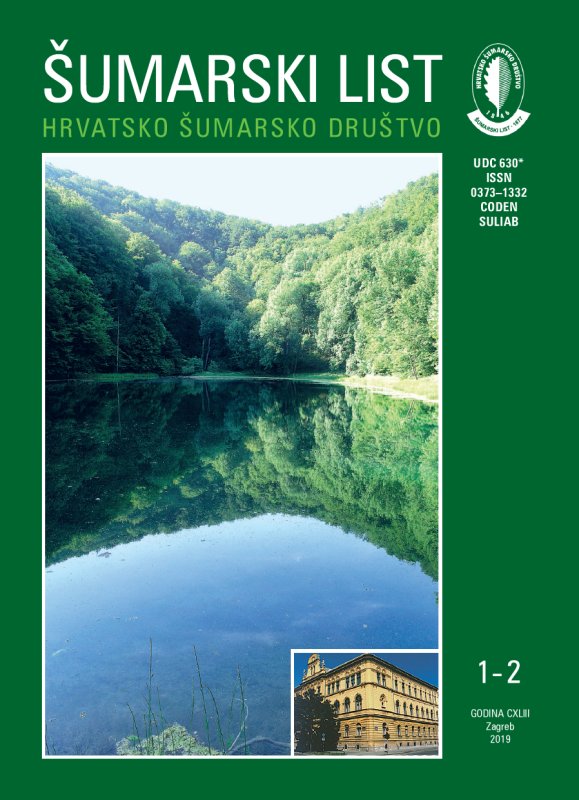
broj: 1-2/2019
pdf (11,35 MB) |
|
||||||||||||||
| RIJEČ UREDNIŠTVA | ||
| Uredništvo | ||
| Is the profession or the system to blame? pdf HR EN | 5 | |
| IZVORNI ZNANSTVENI ČLANCI | ||
| Marijana Žunić, Krunoslav Teslak | UDK 630* 923 + 94 (001) https://doi.org/10.31298/sl.143.1-2.1 | |
| Constraining factors of activities in Croatian forest estates – MIMIC model pdf HR EN | 7 | |
| Luka Kasumović, Ake Lindelöw, Boris Hrašovec | UDK 630* 453 + 153 (001) https://doi.org/10.31298/sl.143.1-2.2 | |
| Overwintering strategy of Ips typographus L. (Coleoptera, Curculionidae, Scolytinae) in Croatian spruce forests on lowest elevation pdf HR EN | 19 | |
| Dalibor Ballian, Emir Lizdo, Faruk Bogunić | UDK 630* 587 (001) https://doi.org/10.31298/sl.143.1-2.3 | |
| Analysis of differences of growth and phenology of provenances of Scots pine (Pinus sylvestris L.) in provenance experiment at Kupres (Bosnia and Herzegovina) pdf HR EN | 25 | |
| Summary Analysis of differences of growth and phenology of provenances of Scots pine (Pinus sylvestris) in provenance experiment at Kupres (Bosnia and Herzegovina) In this paper, 15 European provenance of Scot pines have been analyzed in an international experiment at Kupres. The experiment was established during the spring of 2012 with plants of two years old (2 + 0). A total of 1,800 seedlings of ordinary Scot pine were planted in the experimental design of a casual block system adapted to the terrain, 15 provenances in five repetitions (5 x 36 seedlings). The experiment is made up of ten European countries: Austria (Traisen, Rein, Sistrans), Bosnia and Herzegovina (Bugojno), Ukraine (Ivano Frankivsk), Slovakia (Hanusovce), Romania (Sacueini), Norway (Narvik, Arnes), Germany (Teisendorf , Trippstadt), Poland (Raciane - Nida) and Italy (Ca del Lupo, Fenestrelle, Piani - Valda). The results of morphological and physiological researches relate to differences in survival, height, root neck diameter, and spring phenomenon of bud opening. The total number of seedlings measured is 1830, with the percentage of survival in the year 2017 being 67.70%, and ranging from 35.50% (Italy I1) to 87.70% (Austria A1). Descriptive analysis of the diameter of the root neck was found to have the highest mean diameter of Austria A1 (4.07 cm). The lowest value of the average diameter of the root neck has plants originating in Norway N1 (1.19 cm), root diameter values ranged from 0.30 cm to Norway N1, which is the minimum of 9.30 cm for Austria A1 which represents the maximum when it comes to the average diameter of the neck of the root. With an average height of 116.26 cm, the provenance of Poland P1 shows the highest average value for altitude, while the plants from Norway N1 have the lowest average value for a height of 40.52 cm. All studies have shown a variance analysis that statistically significant differences between investigated provenances are present, as confirmed by Duncan’s test. On the basis of the analysis carried out, it can be concluded that on the basis of the height of the only N1 and Italy I1 provenances, they are separated into separate groups because they have noticeable and far least average values of the seedlings height. On the other hand, as far as diameter on the root of the root can be seen only the N1 Norway proves itself into a separate group with by far the smallest mean diameter. Based on phenological observations, there is variability between all provenances. Differences in movement, duration and end of individual phenomena have been established. As a start of ordinary Scot pine tree vegetation in the international experiment on Kupres can be taken on April 26 because in the three provenances this day the opening of the buds began. In the other 12 provenances the opening of the buds began on May 3, and on 21 June it was noted that the plants in all fifteen investigated the origins have come to the final stage, that is, they have completely formed needles of green color. The first results of the phenological observations show that these studies should continue to determine the overall genetic diversity of ordinary wrinkles, to determine the success and genetic variability of provenances, as well as the behavior and success of different provenances at a given locality. Ordinary pine is genetically differentiated into ecological and vegetation areas, and shows different morphological and physiological characteristics from different areas. This indicates the separation of northern provenances. The research results obtained at the early juvenile stage are incomplete, often burdened with various disadvantages, and very often different from those obtained at later stages, and such research has to be carried out in continuity. Key words: Scot pine (Pinus sylvestris L.); provenance; survival; root neck diameter; height; phenology. | ||
| Tihana Vilović, Suzana Buzjak, Nenad Buzjak | UDK 630*111 + 164 (001) https://doi.org/10.31298/sl.143.1-2.4 | |
| Floristic and microclimatic features of the Sovljak doline (Mt. Velika Kapela, Croatia) pdf HR EN | 35 | |
| Ali Kemal Özbayram | UDK 630* 561+ 242 (001) https://doi.org/10.31298/sl.143.1-2.5 | |
| Diameter increment distribution along the stem of narrow-leaved ash in response to thinning intensity pdf HR EN | 45 | |
| Muberra Pulatkan, Asena Sule Kamber | UDK 630* 232.3 (001) https://doi.org/10.31298/sl.143.1-2.6 | |
| Provenance variation in germination and seedling growth of Rhododendron ponticum L. pdf HR EN | 53 | |
| PREGLEDNI ČLANCI | ||
| Igor Anić | UDK 630* 902 + 945.3 https://doi.org/10.31298/sl.143.1-2.7 | |
| The importance of forestry education and science at the University of Zagreb for the development of Croatian forestry pdf HR EN | 59 | |


